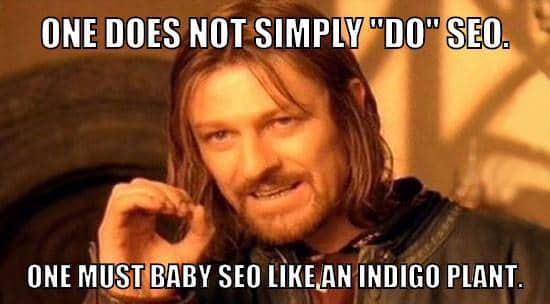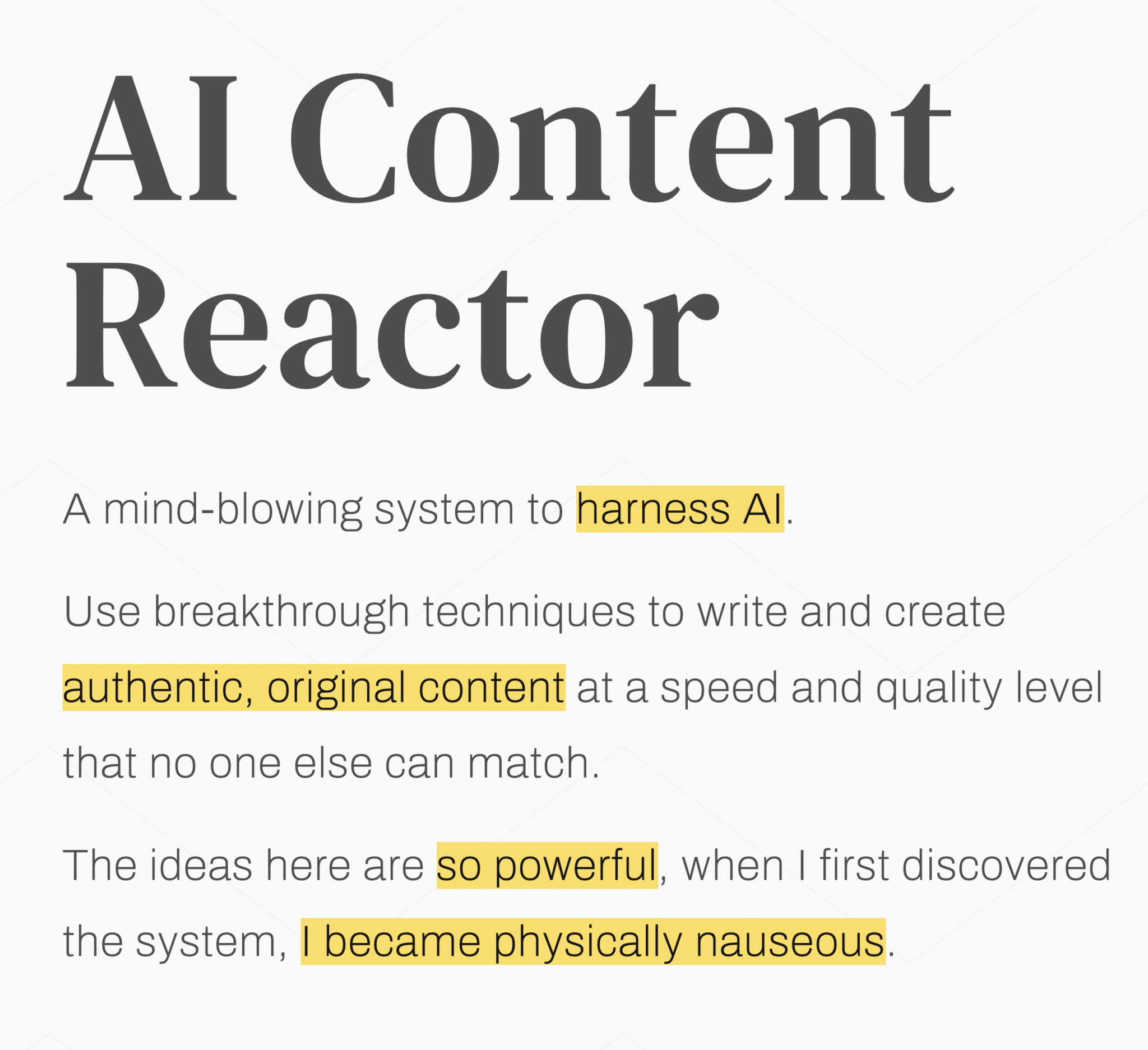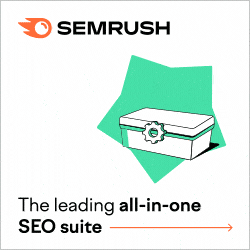In the year 2000, search was a fragmented and inconsistent. It was heavily tied to portals and directories. We had portal engines, metasearch tools, and baby search engines. Google was growing, but had yet to be the giant it is today. And the term “organic SEO” was just beginning to gain traction in the Internet Marketing industry.
Today’s post is an update on our original “what is organic SEO” article. A lot has changed since the early days and search engine optimization in its early form has evolved so dramatically, it barely resembles its early days.
There’s a lot to cover, so let’s get to it!
Table of contents
SEO and marketing to search engines.
When you market online, you have several audiences: search engines, social platforms, and people. We always talk about content and optimization strategies that talk to people, but we can’t ignore the search engines and social platforms. We can’t ignore the algorithms.
Search engine optimization, or SEO, is digital marketing that addresses what search engines want. We choose target keywords, audit our client’s digital presence, and then optimize their website and other digital properties.
For what? Well…
- To rank well in the search engine results pages (SERPs).
- To make sure the search engines can tell that the site fits the user’s search intent.
- To make sure the search engines put you in front of your target audience.
Your online store has to be seen to be visited, and has to be visited for people to purchase. And there’s a lot of competition. Around the world, there are over 28 million online stores actively selling products or services via their sites. There are over 3 million in the U.S. alone. How do you get the word out through all the noise that you’re open for business?
There are several ways to reach your goals, and that’s where the designation for “organic” comes in.
What is organic SEO?
Even in search, there are several ways to market your website. One of these ways is through PPC, otherwise known as Pay-per-Click, “paid search,” or just simply “ads.” PPC is best used in short bursts when you need results fast. For example, if you’re starting a new business, announcing a new product, pushing flash sales, or promoting time-sensitive offers. It’s also a great place to start if you want to test messaging.
Organic SEO was initially coined as a way to distinguish between using ad platforms (Google Ads, Microsoft Advertising, Amazon Ads, Meta Ads, LinkedIn Ads, etc.) and unpaid, natural search rankings. By 2005, organic SEO became synonymous with strategies focused on content quality, relevance, and ethical practices. It was also often used to contrast what had become known as black hat SEO, or “quick fix” ranking tricks.
Organic SEO is very much an active practice today. We might call it different things, (white hat SEO, content-driven SEO, earned SEO, sustainable SEO), but it’s all organic.
In short, organic SEO:
- Highlights earned visibility (not paid).
- Implies a long-term growth strategy, not a transactional one.
- Helps clarify ethical, white-hat practices in contrast to spammy or manipulative tactics.
- Helps as an educational term for people who think of SEO and ads as the same thing.
So while all SEO today technically aims at earning visibility, “organic SEO” remains a helpful distinction, especially in strategic marketing conversations.

What organic SEO doesn’t do.
There’s always some misinformation about search engine optimization. Organic SEO isn’t a quick fix, a one-time checklist, or a shortcut to the top of Google. It’s a strategic, sustainable effort that rewards consistency, value, and user-first thinking. Let’s address some of misinformation that’s out there:
It doesn’t provide instant traffic.
Organic SEO is a long-term game. It can take months to build rankings, especially in competitive spaces. For example, local SEO is a highly competitive arena. If you need clicks tomorrow, SEO isn’t your tool. That’s what PPC is for.
It’s not one-and-done.
SEO isn’t a project you “complete.” Search algorithms evolve, competitors optimize, and user expectations shift. Organic SEO requires ongoing content updates, audits, and refinement.
It doesn’t guarantee first-page rankings.
Even with great SEO, there’s no guarantee you’ll land in the top spot, especially overnight. Rankings depend on competition, intent matching, site health, and authority. Anyone promising #1 rankings before they’ve even seen your target audience, competition, or terms, is selling snake oil.
It’s not just keywords.
If you’re still cramming keywords into your content like it’s 2009, you’re doing it wrong. Modern organic SEO is focuses on serving intent, building topical authority in depth, and creating genuinely helpful content.
It doesn’t replace good UX or design.
SEO might drive traffic, but it won’t keep people on your site if the experience is clunky or inaccessible. Google rewards high-quality user experiences, and bad design can tank engagement and rankings.
It doesn’t work without strategy.
Random blog posts or keyword stuffing won’t drive results. Organic SEO needs to be tied to your business goals, mapped to user intent, and supported by analytics.
It’s not free, it’s just not paid ads.
You might not pay for clicks like in PPC, but organic SEO still costs. Even without an SEO provider, time, tools, content creation, audits, and tech fixes all require resources. It’s a long-term business investment, not a free ride.
The organic SEO landscape is becoming increasingly complex.
Organic SEO isn’t a single tactic. Rather, it’s a combination of smart planning, structural soundness, and a deep understanding of what real people want from your website content. The SEO landscape is more complex now – what with AI, voice search, generative interfaces -, but the foundational pillars remain the same. Get these right and you build a search presence that can grow and evolve with your audience.
Technical Optimization
After a mandatory audit, our organic SEO services run on the FIT strategy (Foundational, Informational, Transactional). The foundational part begins with technical optimization. Remember, SEO needs a good user experience and useful design. This is why technical optimization is so important; it works on the foundation that holds everything else up.
If your site is slow, difficult to crawl, or confusing to search engines, even the best content will struggle with ranking. This means making sure your site is mobile-friendly (or mobile-first), lightning-fast, and structured clearly with schema markup and internal linking that makes sense. Accessibility matters here too. Search engines favor sites that work well across devices and assistive technologies.
Content Strategy
I don’t see “Content is King” as much as I used to, but that doesn’t mean content isn’t still the star of the show. But not just any content. Your SEO efforts should focus on content that’s high-quality, helpful, and written for people first, not just the algorithms.
Yes, of course, like I said above, we can’t ignore the algorithms. The content needs to rank, and so we optimize it for ranking. However, you can’t forget the people, either. And that’s where things like user intent comes into play.
Where you used to only have to worry about what terms people might search, today’s search queries highlight a much smarter search audience. We have entire generations that have never been without a search engine. They expect the results to match their intent, not just the words they use.
Are they looking to learn, compare, or take action? Your content should answer the question before it’s asked, providing clarity, depth, and context. It also means using formats that support discoverability, such as blogs posts, FAQs, videos, and so on.
Link Building and Earning
Backlinks are still one of the strongest signals of authority, but the focus today is much more on earning them rather than building them. There’s an excellent article on Search Engine Land that goes in depth into this topic.
Google’s algorithm is increasingly good at recognizing the difference between meaningful citations and manipulative link schemes. Instead of jumping on reciprocal link tactics that are much less useful now, we earn links by creating content that’s useful, quotable, and shareable. This includes thought leadership, original research, data visualizations, or tools that solve real problems. The best links come naturally from trust, not trades.
User Experience (UX)
Search engines want to give users the best possible experience, so they favor websites that do the same. That means fast load times, intuitive navigation, clean design, and accessibility for all users, including those on mobile devices and using assistive technology.
A strong user experience also means reducing friction: no pop-up overloads, no confusing page layouts, no broken links. In the eyes of both users and search engines, a smooth, inclusive experience builds trust, and trust builds rankings.
How does optimization work?
As a website grows, pages fall out of use. They get old, with outdated information. Terminology changes and words no longer mean the same thing.
Also, as time goes on and the site grows, so does the competition. Online, that means more businesses selling the same things you do, and more website ranking with yours.
Finally, technology changes and people find different ways to search. For online businesses, that means meeting the needs of people that aren’t searching on the traditional desktop anymore.
As an organic SEO company, we target each one of these concerns. We call our process “FIT optimization,” or FIT SEO. Others might call it something else, but proper optimization should always start with an audit, then focus on the foundation – your website.
Our website audits go deep. We assess your current content, your keyword footprint, your messaging, and how well your site aligns with your target audience’s search intent. We run market research, competitor comparisons, content gap analysis, and full keyword audits. We look at backlinks, social signals, and even your brand’s visibility across platforms. We cover the complete gambit, because any weak spot can reduce the effectiveness of everything else.
Then, we prioritize. We separate the issues into foundational, informational, and transactional. We then tackle them in that order unless something in your conversion path is clearly blocking sales.
The first step is optimizing your foundation.
We always begin with the foundation because, if your site isn’t technically sound, no amount of content or creativity is going to stick. Foundational SEO is where we fix what’s broken, strengthen what’s weak, and create a base that supports everything that comes next.
This includes items like your site architecture, page speed, mobile performance, crawlability, and indexing. We look at structured data, schema markup, redirect issues, broken links, and accessibility. It’s not glamorous, but it’s essential. Think of it like building a house. You don’t start decorating until the plumbing works.
This step removes roadblocks. If search engines can’t access your site, or users can’t easily navigate it, your content won’t perform no matter how good it is. So we fix the leaks, patch the gaps, and make sure your site is ready to be discovered, ranked, and trusted.
The second step focuses on providing information.
Each step builds on the previous, so it’s important to have most, if not all, foundational issues fixed before moving forward into the second step.
With the foundation in place, we shift our focus to what people actually find when they land on your site: the information. This is where most businesses either win big or get buried in search results.
If the foundation is your structure, information is your voice. It answers questions, builds authority, and pulls your audience in. Creating content that aligns with user intent at each stage of the buyer’s journey is critical. When the content matches the mindset and needs of your audience at the right moment, you build trust, visibility, and ultimately conversions.
Example: Accessibility for All is marketing their services to website owners who are concerned about being ADA compliant.
1. Awareness Stage (Top of Funnel)
User Intent: “I think I have a problem, but I’m not sure what it is or how to fix it.”
Goal: Educate. Build trust. Show you understand the problem before pitching a solution.
Search queries might include:
- Examples of inaccessible websites
- What is website accessibility?
- Why is accessibility important for websites?
- Who needs an ADA-compliant site?
Content types that work:
- Educational blog posts
- Infographics or explainer videos
- Beginner’s guides
- Checklists or stats-driven content
2. Consideration Stage (Middle of Funnel)
User Intent: “I know the problem and I’m exploring ways to solve it.”
Goal: Position yourself as a credible solution provider. Offer value. Nudge them toward engaging further.
Search queries might include:
- How to make a website ADA compliant
- Best tools for accessibility audits
- Accessibility plugins vs manual audits
- How much does website accessibility cost?
Content types that work:
- Comparison guides
- Tool reviews
- “How-to” content
- Case studies or success stories
- Webinars or downloadable PDFs
3. Decision Stage (Bottom of Funnel)
User Intent: “I’m ready to act, but I need help choosing the right vendor or product.”
Goal: Make it easy to say “yes.” Eliminate friction. Showcase results and offer a clear next step.
Search queries might include:
- Top website accessibility agencies
- Accessibility audit services near me
- Get ADA compliance certificate
- Hire accessibility consultant
Content types that work:
- Service landing pages optimized for conversion
- Client testimonials
- Pricing pages
- Free consultation offers
- Product/service demos or explainer content
If your site only targets bottom-of-funnel, high-converting keywords, you’re missing 70% of the search journey. If you’re only creating awareness content, you’re building traffic, but not momentum.
SEO matches the right content to the right moment, so your brand shows up naturally as the user moves from question → research → decision.
The third step focuses on increasing sales.
Once your site is technically sound and your content answers the right questions at the right time, we move into the transactional phase where visibility turns into revenue.
Conversion rate optimization (CRO) makes sure traffic to the site and on the site has a clear, confident path to take the next step. That might mean scheduling a consultation, adding a product to the cart, filling out a form, or downloading gated content. Whatever your conversion goal is, this step ensures the website actively supports it.
We review everything:
- Are your calls to action clear and aligned with user intent?
- Are your service and product pages persuasive, scannable, and fast-loading?
- Is your messaging consistent from entry point to conversion point?
- Is the mobile experience easy to use and distraction-free?
This also includes internal linking between informational and service pages, removing friction from forms or checkout flows, and integrating trust signals like testimonials, reviews, or guarantees. If we see big issues here during the audit, we don’t wait to address them. After all, there’s no point in driving more traffic to a site that can’t convert.
This step ties the entire FIT framework together. Ranking is all well and good, but it means nothing without conversions. With a solid foundation and strategic content in place, optimizing for conversion ensures your site performs well, not just ranks.
Why do I need an SEO strategy?
Why can’t you just go through and make changes on the fly as you come across them? Well, you can, but consider this. If you make changes willy-nilly:
- You have no way to track what worked and what didn’t.
- You may make changes that conflict with other pages because you haven’t been keeping track.
- You might change something that was working instead of what was actually blocking ranking factors or conversion rates, potentially causing a drop in ranking that could impact traffic and revenue.
You don’t cut a large tree down without figuring out how to do it first. Don’t start trying to optimize your site without a plan.
How does organic SEO translate into better traffic?
Search engines strive to provide the best results for their users. That’s just good business sense. When you have one of the best results, you get ranked high in the search engines. Higher ranking means more traffic.
In fact, studies point to the fact that people love the top four organic listings. In other words, the top four results that aren’t ads. A study from AIOSEO shares some pretty interesting stats. Here are just a few:
- 68% of online activities start with search, and 89% of that starts on Google.
- The top organic search result gets 19x more clicks than paid, and almost 40% of all clicks (but it does depend on the term).
- For many industries, organic search is the second highest channel, beaten only by direct visits (people just type in your website address or name).
- Moving up even one position can increase your click through rate (CTR) by 32.3%.
With these stats and others, it’s clear that organic SEO is a major factor in online sales.
Organic SEO works to provide the best results.
It’s not gaming the system. On the contrary, it’s embracing it. By creating better, more targeted pages, you’re also creating what people want to read. If you give them what they want, they’ll come back. The more often they come back, the more likely they’ll convert… or at least tell someone else (who might convert!).
Wrapping it up.
So, what is organic SEO? I hope we’ve answered that question for you. If you have an online business, it’s a vital part of your success. While there are other forms of marketing, organic SEO is the foundation of long-lasting results. It takes time to implement, but it’s time well spent.
If you think your site is dying and you need help with your organic SEO, contact us today. We’ll help you revitalize your online business the natural way.



































